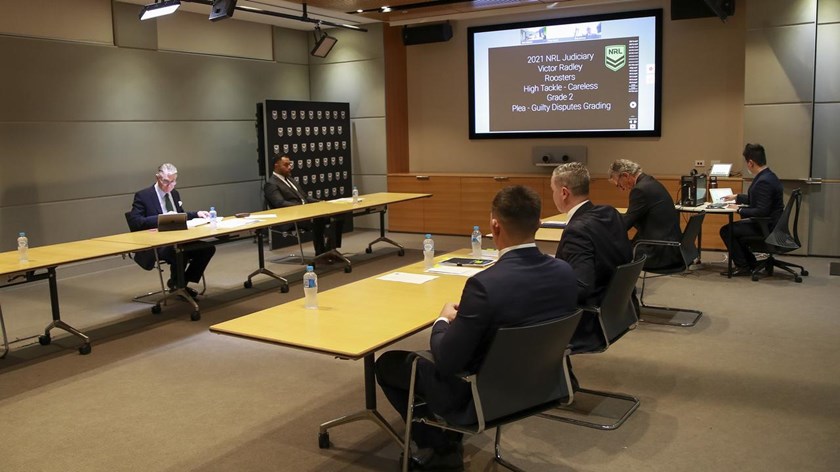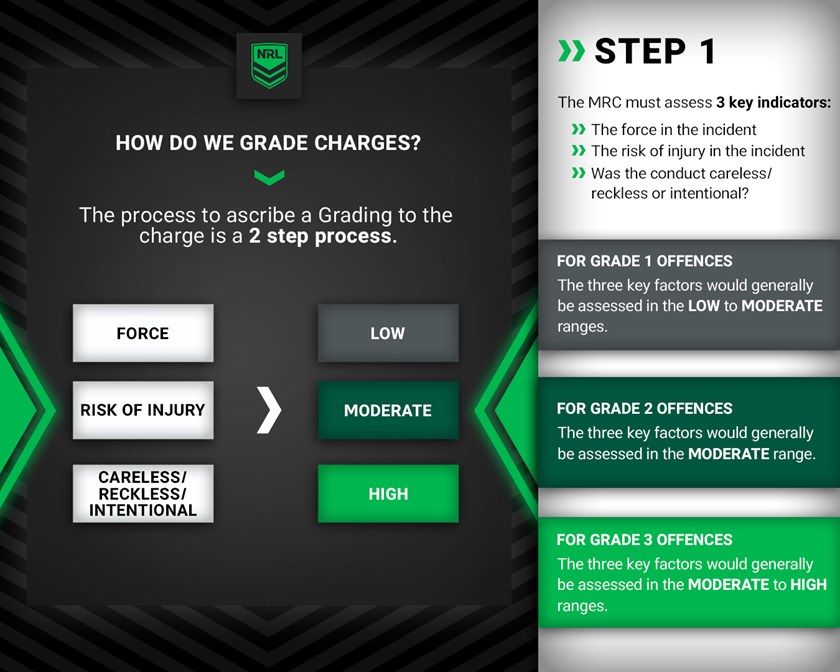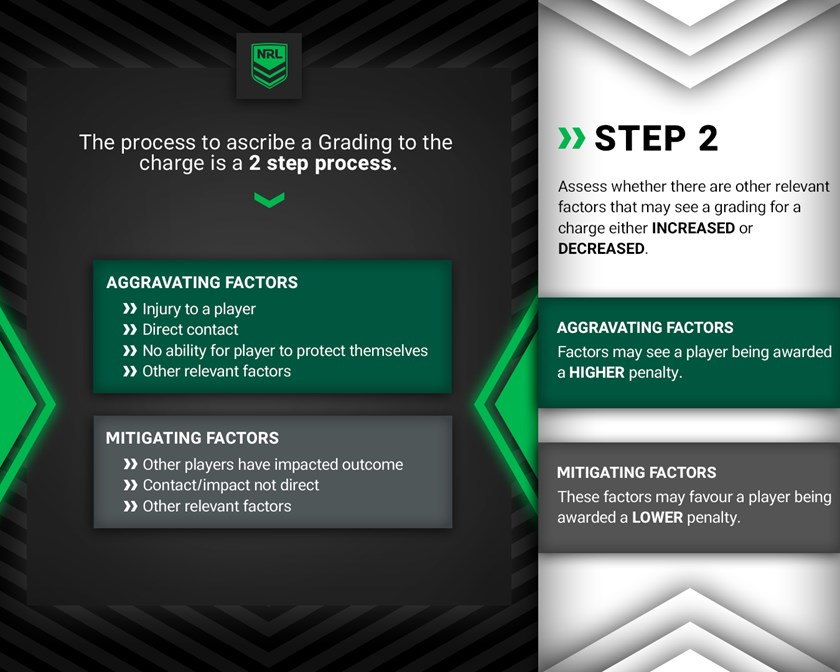How does the system work?
- What is the process to charge a player?
- How is a charge graded by the Match Review Committee?
- How do the NRL judiciary hearings operate?
What is the process to charge a player?
Every match of the Telstra Premiership is reviewed by a member of the Match Review Committee live within the NRL Bunker, looking to identify and highlight concerning incidents of potential misconduct by players in each match.
They use hawk-eye technology to review incidents, looking at every video angle available by our broadcast partners.
The entire NRL MRC meets within 24 hours of the completion of each NRL match. They review all incidents that have been highlighted for discussion that were of concern from the previous days matches and review all video of the incident and any other evidence which may be available which includes match officials reports, including the match referee and touch judges or any complaint that has been received from an NRL club or player.
At the completion of the MRC meeting (within 24 hours of the match), the MRC will form a view as to whether based on the evidence that they have reviewed if there is a reasonable prospect of the player being found guilty of the offence.
In the event of a player being charged, their club will be immediately issued with a notice of charge, which includes details of the particulars of the incident and what the player is accused of, the proposed penalties (either financial penalties or suspension) for the offence and their judiciary record.
The club and player has a period of 24-48 hours to respond to the Notice of Charge, with the player deciding on whether to accept an “early plea” penalty and avoid attending a judiciary hearing. The player will receive a discounted penalty for accepting an “early plea”.
The alternate option is for the player to contest the charge at a hearing of the NRL Judiciary Panel who will determine the outcome of the incident.

How is a charge graded by the Match Review Committee?
After the NRL Match Review Committee has decided that there is sufficient evidence that a player may have committed an offence under the NRL Judiciary Code, their task is then to ascribe a grading to the charge.
The process to ascribe a Grading to the charge is a two-step process.
Step 1
The Match Review Committee review several key indicators that they take into consideration when ascribing a grading. These key indicators must be assessed by the Match Review Committee when reviewing the evidence of each case.
- Force – The MRC must assess the impact of force in each incident the higher the force, the higher the grading.
- Risk of Injury – The MRC must assess the potential for a player of being physically injured during each incident. The higher the risk of Injury, the higher the grading.
- Careless/Reckless/Intentional – The MRC must assess whether the conduct of the player was either careless, reckless or intentional. If the conduct from the player was reckless or intentional, this would be a higher grading.
The Match Review Committee must assess each of these key factors as low, moderate or high. For Grade 1 Offences, the three key factors would generally be assessed in the low to moderate ranges. For Grade 2 Offences, the three key factors would generally be assessed in the moderate range. For Grade 3 Offences, the three key factors would generally be assessed in the moderate to high ranges.

Step 2
The Match Review Committee must also assess whether there are any other relevant factors that be taken into consideration when ascribing a grading to a charge. These other relevant factors may see a grading for a charge either increased or decreased.
The other relevant factors that may see a Grading for a charge increase are called aggravating factors – these factors may see a player being awarded a higher penalty.
The other relevant factors that may see a Grading for a charge decreased are called mitigating factors – these factors may favour a player being award a lower penalty.

Final Decision
- Grade 1 Charges will generally see key indicators in the low to moderate range with no aggravating factors.
- Grade 2 Charges will generally see key Indicators in the moderate range with some aggravating factors. There may also be some other mitigating factors.
- Grade 3 Charges will generally see key indicators in the moderate to high range with several aggravating factors. There is generally no mitigating factors for the player charged.
How do the NRL judiciary hearings operate?
The NRL Judiciary Panel is established to hear and determine charges that players face pursuant to the National Rugby League Code of Procedure.
The NRL Judiciary Panel for each hearing is made up of a Chairman and two panellists.
The current Chairman of the NRL Judiciary is Supreme Court Justice, the Honourable Justice Geoffrey Bellew, who oversees the procedures of hearings including providing legal direction to panellists on each charge and resolving any legal disputes between the two parties.
The NRL Judiciary Panel is made of former players, referees and coaches, with six members for the season. Former international players Bob Lindner and Tony Puletua along with former referees Henry Perenara, Greg McCallum, Sean Hampstead and Paul Simpkins.
The NRL and Match Review Committee is represented at each hearing by the judiciary counsel, who presents the charge and evidence to the judiciary panel. The judiciary counsel for this season is Senior Counsel, Lachlan Gyles SC.
During the hearing, the NRL judiciary counsel and representative of the player provide evidence and submissions to the panel in relation to their case.
For a player to be found guilty, the panel must return a majority verdict which is based on the balance of probabilities, that it is more likely than not that the player committed the offence which they have been charged with. If the player is found not guilty of the charge, they are free to return to playing for their team immediately.
Key Documents

National Rugby League respects and honours the Traditional Custodians of the land and pay our respects to their Elders past, present and future. We acknowledge the stories, traditions and living cultures of Aboriginal and Torres Strait Islander peoples on the lands we meet, gather and play on.